Motorola T250 User Manual
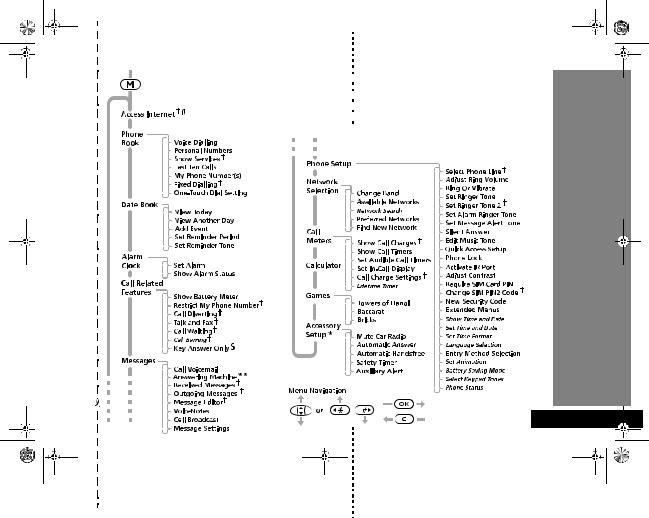
Options Menu
Items shown in Italics are  available only when Extended
available only when Extended  Menus are switched on.
Menus are switched on. 
# If your service provider has  added their own menu, Access
added their own menu, Access  Internet will not be the first
Internet will not be the first  item in the Options menu.
item in the Options menu. 
†Availability depends on the type and settings of the SIM card and/or your subscription to these services where available.
*The Accessory Setup option is available only when a car kit or headset accessory are fitted.
$ Only on phones with a flip.
**This feature is not available in all countries
Quick Reference
English
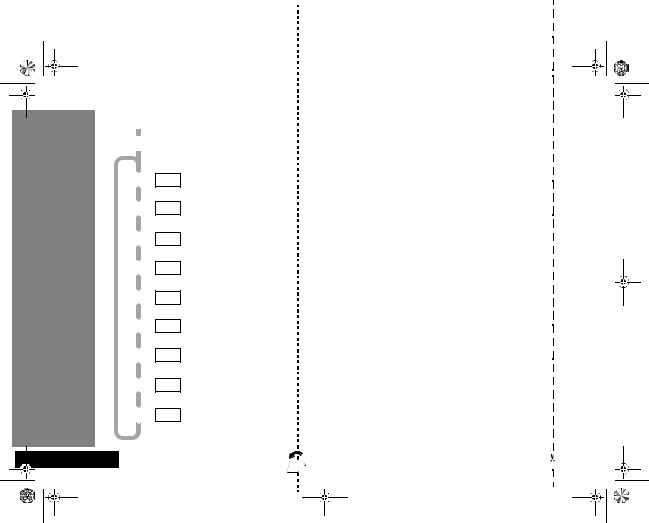
 Quick Reference
Quick Reference
English
Quick Access‡
‡ The features and the positions of the
Efeatures in the Quick Access menu can be changed.
1- Ä1
2- T2
3- «3
4- G4
5- }5
6- B6
7- K7
8- L8
Access Internet?
Add to SIM?
Activate IR?
Battery Meter?
Play VoiceNotes?
Find Name?
Read Messages?
Vibrate On/Off?
9- P9 Divert On/Off?
Special Keys
SPress to turn phone on and off.
OPress to accept call, setting, option,...
CPress to reject call, setting, option,...
EPress to enter the Quick Access features.
$ Press to access the options or phone book menus.
<> Press both simultaneously to lock the keypad on flipless models; also use to scroll left and right.
ªPull down to scroll forwards and push up to scroll backwards.
fPress to call Voicemail.
Making a Call
Enter CO.
Receiving a Call
Press O.
Ending a Call
Press Oor C.
Making an Emergency Call
Enter 112O. The call will be directed to a central emergency operator.
Quick Access Features
Press Efollowed by the appropriate key, or press E, scroll to the feature and press Oto select.
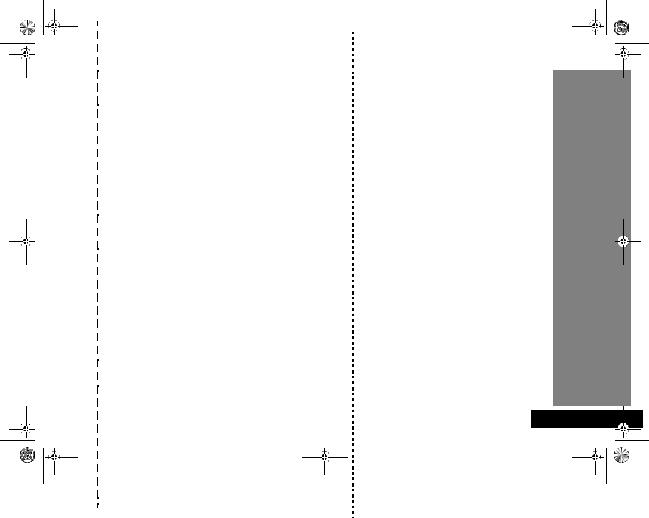
Adjust Ringer Volume
Press Efollowed by the volume button to either increase or decrease the ringer volume.
Recording a VoiceNote™
Press the Start/Stop Record button (?) on the top of the phone. Press the button again to stop recording.
Playing a VoiceNote™
Select Messages, VoiceNote™, Play VoiceNotes™, or use the Quick Access item.
Redialling the Last Number Called
1Press Oto display the last number dialled (Made Calls).
2Press Oto call the number.
3Select Call Number and press O.
One-Touch Dialling
Press and hold the appropriate digit key 1to 9.
Recalling a Number from the Phone Book
Press the Smart button (=) and then use the volume button to scroll to the stored number, or press the appropriate digit key to skip to a particular letter. To make the call, either hold down =for 1.5 seconds or press
O.
Dialling Phone Book Numbers
Enter G>O
Stopping a Call Alert
Press the volume button when the phone is ringing or vibrating. This will stop the alert but not answer the call.
 Voice Dialling
Voice Dialling
Press the Smart button (=). If there is a Phone Book entry
with a Voice Tag the prompt Say Name After Tone...
appears. Wait for the tone to finish and then say the name associated with the number you want to call.
Quick Reference
English
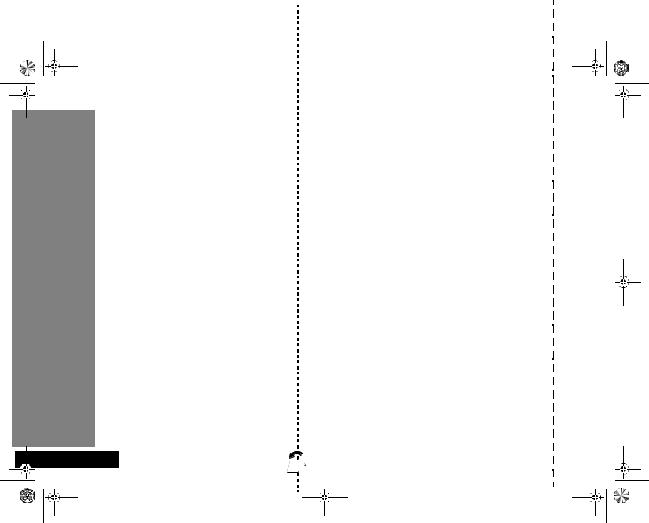
 Quick Reference
Quick Reference
English
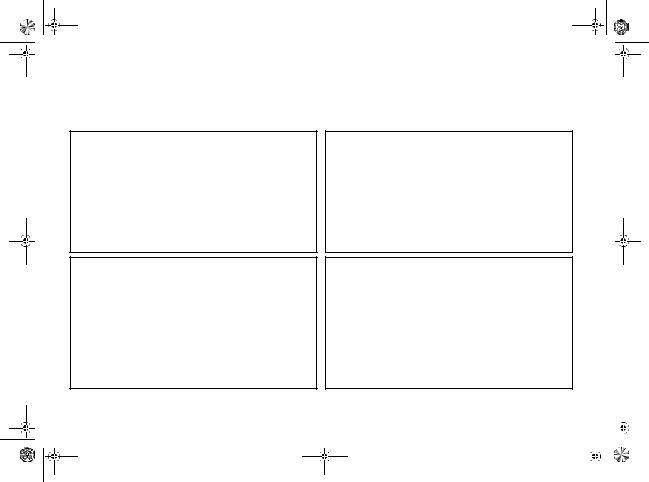
Introduction
Welcome
Congratulations on your purchase of a mobile phone from Motorola, the world leader in cellular technology. The phones are packed with features that put you in control and give you unrivalled power, whilst remaining discrete.
Control
•Customisable Quick Access Menu E- Place nine of your most frequently used features in your own personal menu so that they can be accessed with just two key presses. Icons make each feature easy to identify.
•VoiceNotes™ feature }- Allows you to record a number of personal voice messages or to record part of a phone call - useful when you haven’t got pen and paper to hand for taking down directions or a message.
•Voice Control - Use voice commands to call up Phone Book entries and to select Quick Access options.
Discretion
•VibraCall™ L- In locations where you don’t want your phone to ring, or which are too noisy to hear your phone ring, your phone can vibrate to alert you of a call.
•Wearable Holster - Wear your phone in a stylish holster on your belt. It is small enough and light enough to keep with you almost anywhere.
•Stop Call Alert - Press the volume button when the phone is ringing or vibrating. This will stop the alert but not answer the call.
Power
•Superb battery performance G- Each phone is capable of several hours conversation or several days standby, but is still small and light.
•Tri Band - versions of the phone include the powerful Tri Band feature which means that they can use 900, 1800 and 1900MHz bands for greater call success and allow wider roaming opportunities.
!Before you use your phone, please see the ‘Your Battery’ section for important information on charging a new battery.
Personality™
This cellular telephone incorporates Personality™. Unique to Motorola, Personality™ removes the complexity of cellular communications by guiding you through the features and presenting you with simple choices every step of the way. Personality™ also allows you to personalise the way you use your phone - for example, different ringer tones, a phone book and network selection preferences - all presented with clarity and simplicity. In this manual, each of the Personality™ features is identified with an jsymbol to indicate that it is customisable to meet your requirements.
Introduction 1 |
|
|
|
|
|
|
|
|
|
English |
|
|
|||||||
|
|
|
|
|
|
|
|
|
|
|
|
|
|
|
|
|
|
|
|
|
|
|
|
|
|
|
|
|
|
|
|
|
|
|
|
|
|
|
|
|
|
|
|
|
|
|
|
|
|
|
|
|
|
|
|
|
|
|
|
|
|
|
|
|
|
|
|
|
|

Understanding this Manual
Many of your phone options are accessed by a simple menu system. A full description of the menus and how to move around them is covered in the next section Menu Navigation. When the manual describes the use of each menu item, it will be assumed that you are familiar with the menu system.
Key Presses
Key presses are represented in this manual using symbols so that you may locate and use the required sequence quickly. A sequence of key presses may be shown as follows:
$OC
This means that you should press the $ key followed by the Okey and then the Ckey, in sequence, not simultaneously.
Entering Information
When you are requested to enter information, such as the number of the phone you wish to call, this is represented in bold type. For example:
C- enter the required telephone number.
A- enter your Personal Identification Number.
B- enter your unlock code.
G- enter the Phone Book location number.
Prompts and Messages
Your phone responds to key presses by displaying either easy to understand prompts that guide you to the next action, or simple messages confirming that your action is complete. Prompts and messages are represented in this manual in LCD style, for example:
Enter PIN or Completed.
Other Symbols
You will find the following symbols used throughout this manual:
AA Note contains additional information which is relevant to the feature/item.
!A Caution contains important additional information which is relevant to the efficient and/or safe usage of your phone.
jThis symbol indicates that the feature is a Personality™ feature that can be customised to meet your requirements.
i This symbol indicates a short key sequence for the feature.
|
|
|
|
|
|
|
|
|
|
|
|
|
|
|
|
English |
2 |
Introduction |
|
|
|
|
|
|
|
|
|
|
|
|
|
|
|
|
|
|
|
|
|
|
|
|
|
|
|
|
|
|
|
|
|
|
|
|
|
|
|
|
|
|
|
|
|
|
|
|
|
|
|
|
|
|
|
|
|
|
|
|
|
|
|
|
|
|
|
|
|
|
|
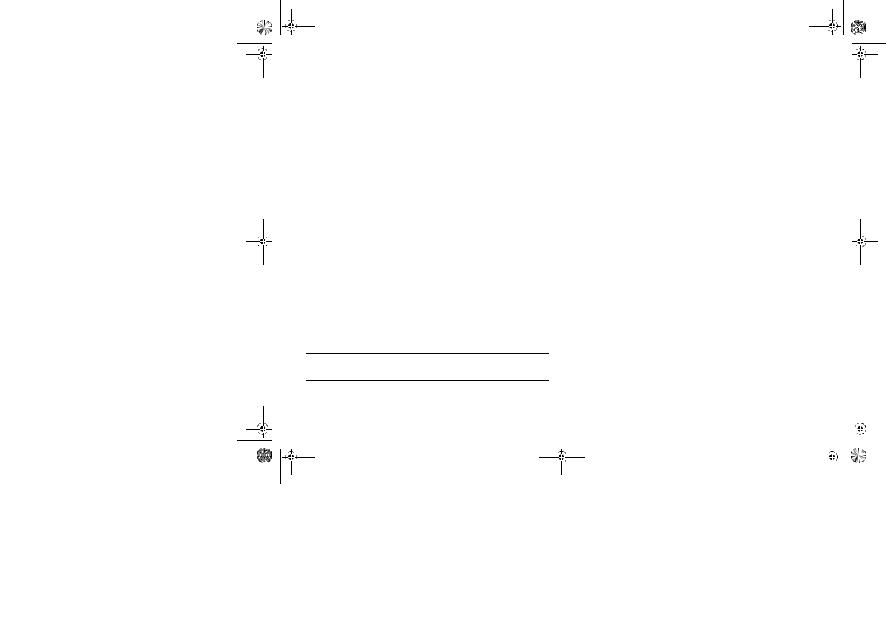
Menu Navigation
A large number of your phone's options are accessed by using menus which use a common approach for selection, change and cancellation.
Please read this section carefully before attempting to access a menu option. When you understand the common approach to menu navigation and how the menus are shown on the page, you will be able to access and change options with ease.
Entering the Menus
Two different keys are used to access the menus:
$ enters the Options menu whilst in standby mode; enters the In-call menu during a call.
Eenters the Quick Access menu.
Once entered, the menus use the ª, <, >, Oand Ckeys in a common manner to access, select and change individual options.
AYou can use the ªor <, >keys to scroll round the menus in either direction.
Leaving the Menus
To leave any of the menus, you can either press and hold the Ckey or repeatedly press the Ckey. Both of these actions will return your phone to the standby mode.
iAlternatively, a quicker way to leave the menus is to press
EC.
Menus and Sub-menus
A menu is a simple list of options. Some of these options provide access to a further list of options called a sub-menu. When navigating through the menus you may find it is helpful to think in terms of menu levels - the ‘parent’ menu being on one level and its sub-menus being on a lower level.
Moving To and Selecting a Menu Option
To move from one option to another on the same level, use the scroll key (ª). Pull ªdown to move forwards and push ª up to move backwards. When you find the option you want, press the Okey to select it.
Depending on the option you select, one of three things will happen:
•either a brief message will be displayed confirming an action, for example Completed.
•or a prompt will be displayed requesting you to enter information, for example Enter PIN or Enter Name.
•or the first option of a sub-menu will be displayed. You can select this option using the Okey or browse through the other options using the scroll key.
To leave an option or sub-menu, press the Ckey. This will take you back to the parent menu item.
Menu Options with Security Codes
Some options are protected from misuse by requiring you to enter one of the security codes. To use these options, you must enter the requested code before proceeding.
|
|
|
|
|
|
|
|
|
|
Introduction 3 |
English |
|
|
|
|||||
|
|
|
|
|
|
|
|
|
|
|
|
|
|
|
|
|
|
|
|
|
|
|
|
|
|
|
|
|
|
|
|
|
|
|
|
|
|
|
|
|
|
|
|
|
|
|
|
|
|
|
|
|
|
|
|
|
|
|
|
|
|
|
|
|
|
|
|
|
|
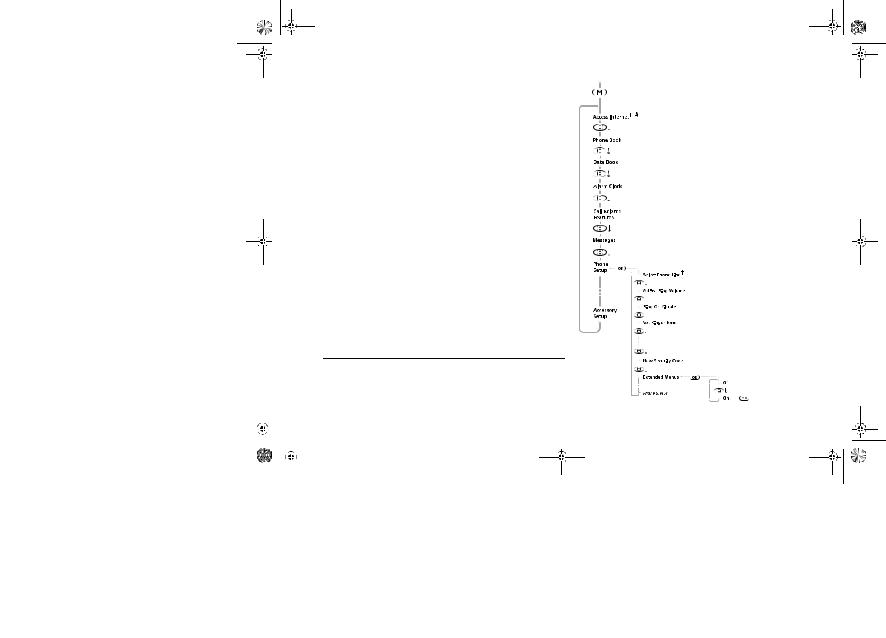
Menu Navigation - A Working Example
The following steps will take you through how to switch the
Extended Menus option on:
1When the phone is in the standby mode, press the $ key.
This will access the Options menu and Access Internet will be displayed.#
2Press the ª« key repeatedly until the Phone Setup sub-menu item is shown in the display.
3Press the Okey to select the sub-menu.
4Press the ª« key repeatedly until the Extended Menus submenu item is shown in the display.
5Press the Okey to select this item. You can now select between On or Off, the current setting will be shown with a z character. If the zcharacter is next to Off, press ª©and then Oto switch on the Extended Menus. If the z character is next to On, press Cto leave the setting as it is.
#If your service provider has added their own menu, Access Internet will not be the first item in the Options menu.
†Availability depends on the type and settings of the SIM card and/or your subscription to these services where available.
|
|
|
|
|
|
|
|
|
|
|
|
|
|
|
|
English |
4 |
Introduction |
|
|
|
|
|
|
|
|
|
|
|
|
|
|
|
|
|
|
|
|
|
|
|
|
|
|
|
|
|
|
|
|
|
|
|
|
|
|
|
|
|
|
|
|
|
|
|
|
|
|
|
|
|
|
|
|
|
|
|
|
|
|
|
|
|
|
|
|
|
|
|

jShort, Extended and Personalised Menus
With Personality™ you can personalise the menus by choosing which features you want readily available. The features that are less frequently used can be stored out of sight.
The menu diagrams in this manual show the condition of the menu settings when you first receive your phone. Some features are in the Short Menu and are shown in bold type. Other features are in the Extended Menu and appear in italics.
You can change which features appear in the Short and Extended Menus, and therefore personalise the menus, to suit your requirements.
If you want to move a feature from the Short Menu to the Extended Menu (or from the Extended Menu to the Short Menu), go to the feature and then hold down the Okey until a prompt appears offering the following choices:
•Add the current feature to the Short Menu/Extended Menu.
•Leave the current feature in the Short/Extended Menu. Select the option you want by pressing the Okey.
Total Customer Satisfaction
At Motorola, Total Customer Satisfaction is a top priority. If you have a question, a suggestion or a concern about your Motorola Cellular Phone, Motorola wants to hear from you.
For e-mail queries contact: mcrc@ei.css.mot.com
|
|
|
|
|
|
|
|
|
|
Introduction 5 |
English |
|
|
|
|||||
|
|
|
|
|
|
|
|
|
|
|
|
|
|
|
|
|
|
|
|
|
|
|
|
|
|
|
|
|
|
|
|
|
|
|
|
|
|
|
|
|
|
|
|
|
|
|
|
|
|
|
|
|
|
|
|
|
|
|
|
|
|
|
|
|
|
|
|
|
|

Warranty Information
Motorola guarantees to you, the original purchaser, the Personal Communicator and accessories which you have purchased from an authorised Motorola dealer (the “Products”), to be in conformance with the applicable Motorola specifications current at the time of manufacture for a term of [1] year from date of purchase of the Product(s) (Warranty Term).
You must inform Motorola of the lack of conformity to the applicable specifications of any of the Products within a period of two (2) months from the date on which you detect a defect in material, workmanship or lack of conformity and in any event within a term not to exceed the Warranty Term, by submitting the Product for service to Motorola. Motorola shall not be bound by Product related statements not directly made by Motorola.
A list of the Motorola Call Centre numbers is enclosed with this
Product.
During the Warranty term, Motorola will, at its discretion and without extra charge, as your exclusive remedy, repair or replace your Product which does not comply with this warranty; or failing this, to reimburse the price of the Product but reduced to take into account the use you have had of the Product since it was delivered. This warranty will expire at the end of the Warranty Term.
This is the complete and exclusive warranty for a Motorola Personal Communicator and accessories and in lieu of all other warranties, terms and conditions, whether express or implied.
Where you purchase the product other than as a consumer, Motorola disclaims all other warranties, terms and conditions express or implied, such as fitness for purpose and satisfactory quality.
|
|
|
|
|
|
|
|
|
|
|
|
|
|
|
|
English |
6 |
Introduction |
|
|
|
|
|
|
|
|
|
|
|
|
|
|
|
|
|
|
|
|
|
|
|
|
|
|
|
|
|
|
|
|
|
|
|
|
|
|
|
|
|
|
|
|
|
|
|
|
|
|
|
|
|
|
|
|
|
|
|
|
|
|
|
|
|
|
|
|
|
|
|
In no event shall Motorola be liable for damages nor loss of data in excess of the purchase price nor for any incidental special or consequential damages# arising out of the use or inability to use the Product, to the full extent such may be disclaimed by law.
This Warranty does not affect any statutory rights that you may have if you are a consumer, such as a warranty of satisfactory quality and fit for the purpose for which products of the same type are normally used under normal use and service, nor any rights against the seller of the Products arising from your purchase and sales contract.
How to Get Warranty Service?
In most cases the authorised Motorola dealer which sold and/or installed your Motorola Personal Communicator and original accessories will honour a warranty claim and/or provide warranty service. Alternatively, for further information on how to get warranty service please contact either the customer service department of your service provider or Motorola’s call centre at the telephone numbers below for your country.
In order to claim the warranty service you must return the Personal Communicator and/or accessories in question to Motorola please avoid leaving any supplementary items like SIM cards. The Product should also be accompanied by a label with your name, address, and telephone number; name of operator and a description of the problem. In the case of vehicular installation, the vehicle in which the Personal Communicator is installed should be driven to the Authorised Repair Centre, as analysis of any problem may require inspection of the entire vehicular installation.
#including without limitation loss of use, loss of time, loss of data, inconvenience, commercial loss, lost profits or savings.

In order to be eligible to receive warranty service, you must present your receipt of purchase or a comparable substitute proof of purchase bearing the date of purchase. The phone should also clearly display the original compatible electronic serial number (IMEI) and mechanic serial number [MSN]. Such information is contained with the Product.
Conditions
This warranty will not apply if the type or serial numbers on the Product has been altered, deleted, duplicated, removed, or made illegible. Motorola reserves the right to refuse free-of-charge warranty service if the requested documentation cannot be presented or if the information is incomplete, illegible or incompatible with the factory records.
Repair, at Motorola's option, may include reflashing of software, the replacement of parts or boards with functionally equivalent, reconditioned or new parts or boards. Replaced parts, accessories, batteries, or boards are warranted for the balance of the original warranty time period. The Warranty Term will not be extended. All original accessories, batteries, parts, and Personal Communicator equipment that have been replaced shall become the property of Motorola. Motorola does not warrant the installation, maintenance or service of the products, accessories, batteries or parts.
Motorola will not be responsible in any way for problems or damage caused by any ancillary equipment not furnished by Motorola which is attached to or used in connection with the Products, or for operation of Motorola equipment with any ancillary equipment and all such equipment is expressly excluded from this warranty.
When the Product is used in conjunction with ancillary or peripheral equipment not supplied by Motorola, Motorola does
not warrant the operation of the Product/peripheral combination and Motorola will not honour any warranty claim where the Product is used in such a combination and it is determined by Motorola that there is no fault with the Product. Motorola specifically disclaims any responsibility for any damage, whether or not to Motorola equipment, caused in any way by the use of the Personal Communicator, accessories, software applications and peripherals (specific examples include, but are not limited to: batteries, chargers, adapters, and power supplies) when such accessories, software applications and peripherals are not manufactured and supplied by Motorola.
What Is Not Covered by the Warranty
This warranty is not valid if the defects are due to damage, misuse, tampering, neglect or lack of care and in case of alterations or repair carried out by unauthorised persons.
1Defects or damage resulting from use of the Product in other than its normal and customary manner.
2Defects or damage from misuse, access to incompatible sources, accident or neglect.
3Defects or damage from improper testing, operation, maintenance, installation, adjustment, unauthorised software applications or any alteration or modification of any kind.
4Breakage or damage to antennas unless caused directly by defects in material or workmanship.
5Products disassembled or repaired in such a manner as to adversely affect performance or prevent adequate inspection and testing to verify any warranty claim.
6Defects or damage due to range, coverage, availability, grade of service, or operation of the cellular system by the cellular operator.
|
|
|
|
|
|
|
|
|
|
Introduction 7 |
English |
|
|
|
|||||
|
|
|
|
|
|
|
|
|
|
|
|
|
|
|
|
|
|
|
|
|
|
|
|
|
|
|
|
|
|
|
|
|
|
|
|
|
|
|
|
|
|
|
|
|
|
|
|
|
|
|
|
|
|
|
|
|
|
|
|
|
|
|
|
|
|
|
|
|
|

7Defects or damage due to moist, liquid or spills of food.
8Control unit coil cords in the Product that are stretched or have the modular tab broken.
9All plastic surfaces and all other externally exposed parts that are scratched or damaged due to customer normal use.
10Leather cases (which are covered under separate manufacturer's warranties).
11Products rented on a temporary basis.
12Periodic maintenance and repair or replacement of parts due to normal wear and tear;
AThe talk-time, stand-by time and total life cycle of a Motorola rechargeable battery for your Personal Communicator will depend on usage conditions and network configurations. As a consumable product, the specifications indicate that you should be able to obtain optimum performance for your Motorola Personal Communicator within the first six months from date of purchase and up-to (200) charges.
The warranty for Motorola rechargeable batteries becomes void if
(i) the batteries are charged other than by Motorola approved battery chargers specified for the charging of the battery, (ii) any of the seals on the battery are broken or show evidence of tampering, (iii) the battery is used in equipment or services other than the cellular telephone equipment for which it is specified.
|
|
|
|
|
|
|
|
|
|
|
|
|
|
|
|
English |
8 |
Introduction |
|
|
|
|
|
|
|
|
|
|
|
|
|
|
|
|
|
|
|
|
|
|
|
|
|
|
|
|
|
|
|
|
|
|
|
|
|
|
|
|
|
|
|
|
|
|
|
|
|
|
|
|
|
|
|
|
|
|
|
|
|
|
|
|
|
|
|
|
|
|
|
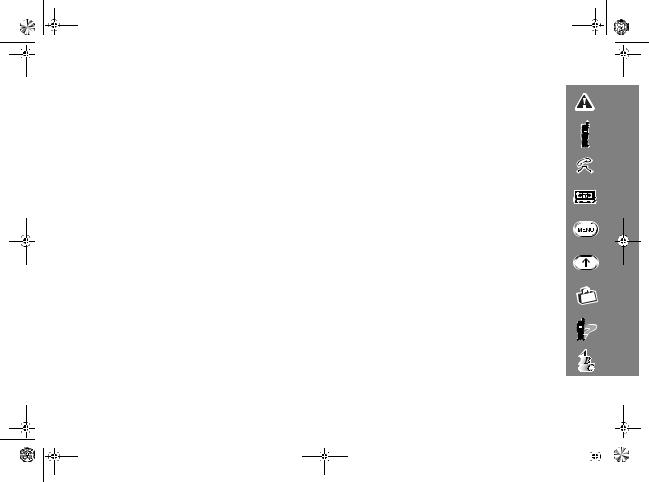
!
Contents |
|
Safety and General Information |
|
Important information for the efficient and safe operation of your phone .............................................................................. |
11 |
About Your Phone, Battery and SIM Card |
|
Introduces your phone, explains how to charge and maintain batteries, explains about your SIM Card............................... |
15 |
Making and Receiving Phone Calls |
|
Explains how to make single or conference calls, how to redial, how to transfer a call, and how to end a call.................... |
25 |
Using Voice Features |
|
Explains how to use the VoiceNotes™ and Voice Control features on your phone .................................................................. |
35 |
Using the Options Menu |
|
Provides an explanation of the Options Menu and how to use it .............................................................................................. |
43 |
Using the Quick Access Menu |
|
Provides an explanation of the Quick Access Menu and how to use it.................................................................................... |
105 |
Accessories |
|
Details the accessories available for use with your phone........................................................................................................ |
111 |
What to do if... |
|
Helps you to solve any problems that may occur....................................................................................................................... |
113 |
Index |
|
A comprehensive Index ................................................................................................................................................................ |
115 |
The Manufacturer reserves the right to make changes in technical and product specifications without prior notice.
Contents 9 |
English |
|
|
|
|||
|
|
|
|
|
|
|
|
|
|
|
|
|
|
|
|
|
|
|
|
|
|
|
|
|
|
|
|
|
|
|
|
|
|
|
|
|
|
|
|

|
|
|
|
|
|
|
|
|
|
|
|
|
|
|
English |
10 Contents |
|
|
|
|
|
|
|
|
|
|
|
|
|
|
|
|
|
|
|
|
|
|
|
|
|
|
|
|
|
|
|
|
|
|
|
|
|
|
|
|
|
|
|
|
|
|
|
|
|
|
|
|
|
|
|
|
|
|
|
|
|
|
|
|
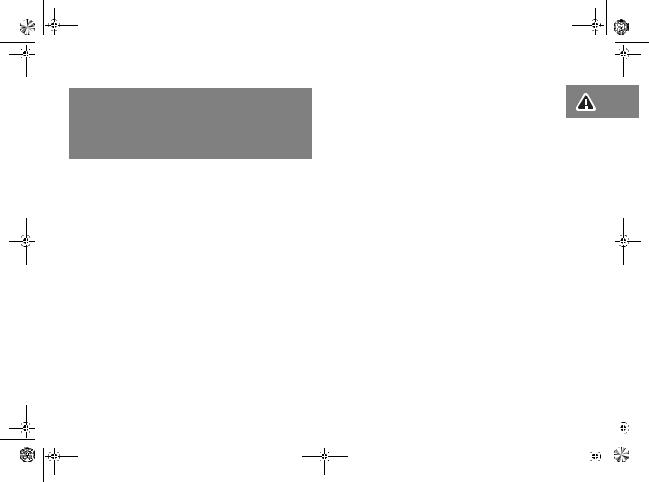
Safety and General Information
Important Information on Safe and Efficient Operation
Read This Information Before Using
Your Personal Communicator
The information provided in this document supersedes the general safety information contained in user guides published prior to this date. For information regarding radio use in a hazardous atmosphere please refer to the Factory Mutual (FM) Approval Manual Supplement or Instruction Card, which is included with radio models that offer this capability.
RF Operational Characteristics
Your Personal Communicator contains a transmitter and a receiver. When it is ON, it receives and transmits radio frequency (RF) energy. The Personal Communicator operates in the frequency range of 900 MHz to 1990 MHz and employs digital modulation techniques.
When you communicate with your Personal Communicator, the system handling your call controls the power level at which your personal communicator transmits. The output power level typically may vary over a range from 0.063 watts to 1.58 watts.
Exposure To Radio Frequency Energy
Your Motorola Personal Communicator is designed to comply with the following national and international standards and guidelines regarding exposure of human beings to radio frequency electromagnetic energy:
•United States Federal Communications Commission, Code of Federal Regulations; 47 CFR part 2 sub-part J
•American National Standards Institute (ANSI) / Institute of Electrical and Electronic Engineers (IEEE) C95. 1-1992
•Institute of Electrical and Electronic Engineers (IEEE) C95.1-1999 Edition
•National Council on Radiation Protection and Measurements (NCRP) of the United States, Report 86, 1986
•International Commission on Non-Ionizing Radiation Protection (ICNIRP) 1998
•National Radiological Protection Board of the United Kingdom 1995
•Ministry of Health (Canada) Safety Code 6. Limits of Human Exposure to Radiofrequency Electromagnetic Fields in the Frequency Range from 3 kHz to 300 GHz, 1999
•Australian Communications Authority Radiocommunications (Electromagnetic Radiation - Human Exposure) Standard 1999 (applicable to wireless phones only)
To assure optimal performance and make sure human exposure to radio frequency electromagnetic energy is within the guidelines set forth in the above standards, always adhere to the following procedures:
Safety and General Information 11 |
|
|
|
|
|
|
|
|
|
English |
|
|
|
|
|
||||
|
|
|
|
|
|
|
|
|
|
|
|
|
|
|
|
|
|
|
|
|
|
|
|
|
|
|
|
|
|
|
|
|
|
|
|
|
|
|
|
|
|
|
|
|
|
|
|
|
|
|
|
|
|
|
|
|
|
|
|
|
|
|
|
|
|
|
|
|
|
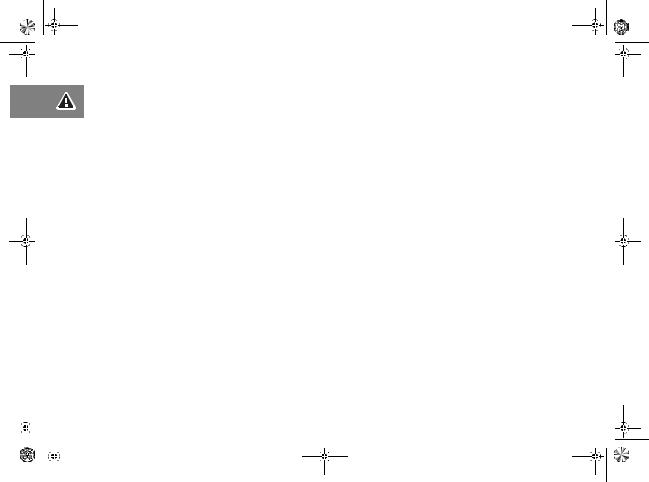
Portable Personal Communicator Operation
and EME Exposure
Antenna Care
Use only the supplied or an approved replacement antenna. Unauthorized antennas, modifications, or attachments could damage the Personal Communicator and may violate FCC and/or other applicable regulations.
DO NOT hold the antenna when the Personal Communicator is “IN USE”. Holding the antenna affects call quality and may cause the Personal Communicator to operate at a higher power level than needed.
Phone Operation
The Personal Communicator is designed to be used with a headset for talking and listening. The Personal Communicator can also be placed inside the holster, then the holster can be clipped onto your belt, pocket, handbag, or other apparel and used with the headset.
Body-worn Operation
To maintain compliance with FCC RF exposure guidelines, if you wear the Personal Communicator on your body when transmitting, always place the Personal Communicator in a Motorola supplied or approved clip, holder, holster, case, or body harness. Use of non-Motorola-approved accessories may exceed FCC RF exposure guidelines. If you do not use a body-worn accessory, ensure the antenna is at least one inch (2.5 cm) from your body when transmitting.
Approved Accessories
For a list of approved Motorola accessories, look in the accessory section of this manual.
|
|
|
|
|
|
|
|
|
|
|
|
|
|
|
|
|
English |
12 Safety and General Information |
|
|
|
|
|
|
|
|
|
|
|
|
|
|
|
|
|
|
|
|
|
|
|
|
|
|
|
|
|
|
|
|
|
|
|
|
|
|
|
|
|
|
|
|
|
|
|
|
|
|
|
|
|
|
|
|
|
|
|
|
|
|
|
|
|
|
|
|
|
|
|
Electromagnetic Interference/Compatibility
Nearly every electronic device is susceptible to electromagnetic interference (EMI) if inadequately shielded, designed or otherwise configured for electromagnetic compatibility.
Facilities
To avoid electromagnetic interference and/or compatibility conflicts, turn off your Personal Communicator in any facility where posted notices instruct you to do so. Hospitals or health care facilities may be using equipment that is sensitive to external RF energy.
Aircraft
When instructed to do so, turn off your Personal Communicator when on board an aircraft. Any use of a Personal Communicator must be in accordance with applicable regulations per airline crew instructions.
Medical Devices
Pacemakers
The Health Industry Manufacturers Association recommends that a minimum separation of 6 inches (15 centimetres) be maintained between a handheld wireless phone and a pacemaker. These recommendations are consistent with the independent research by, and recommendations of, Wireless Technology Research.
Persons with pacemakers should:
•ALWAYS keep the Personal Communicator more than six inches (15 centimeters) from their pacemaker when the Personal Communicator is turned ON.
•not carry the Personal Communicator in the breast pocket.

•use the ear opposite the pacemaker to minimize the potential for interference.
•turn the Personal Communicator OFF immediately if you have any reason to suspect that interference is taking place.
Hearing Aids
Some digital wireless phones may interfere with some hearing aids. In the event of such interference, you may want to consult your hearing aid manufacturer to discuss alternatives.
Other Medical Devices
If you use any other personal medical device, consult the manufacturer of your device to determine if it is adequately shielded from RF energy. Your physician may be able to assist you in obtaining this information.
Safety and General
Use in Vehicles
Check the laws and regulations on the use of phones in your vehicle. You are advised to always obey them.
When using your Personal Communicator in a vehicle, please:
•Use hands-free operation, if available.
•Pull off the road and park before making or answering a call.
Operational Warnings
For Vehicles with an Air Bag
Do not place the Personal Communicator in the area over an air bag or in the air bag deployment area. Air bags inflate with great force. If the Personal Communicator is placed in the air bag deployment area and the air bag inflates, the Personal Communicator may be propelled with great force and cause serious injury to occupants of the vehicle.
Potentially Explosive Atmospheres
Turn off your Personal Communicator prior to entering any area with a potentially explosive atmosphere, unless it is especially qualified for use in such areas as “Intrinsically Safe” (for example, Factory Mutual, CSA, or UL Approved). Do not remove, install, or charge batteries in such areas. Sparks in a potentially explosive atmosphere can cause an explosion or fire resulting in bodily injury or even death.
The areas with potentially explosive atmospheres referred to above include fuelling areas such as below decks on boats, fuel or chemical transfer or storage facilities, areas where the air contains chemicals or particles, such as grain, dust or metal powders, and any other area where you would normally be advised to turn off your vehicle engine. Areas with potentially explosive atmospheres are often but not always posted.
Blasting Caps and Areas
To avoid possible interference with blasting operations, turn off your Personal Communicator when you are near electrical blasting caps, in a blasting area, or in areas posted: “Turn off two-way radio”. Obey all signs and instructions.
|
|
|
|
|
|
|
|
|
|
Safety and General Information 13 |
English |
|
|
|
|
|
|||
|
|
|
|
|
|
|
|
|
|
|
|
|
|
|
|
|
|
|
|
|
|
|
|
|
|
|
|
|
|
|
|
|
|
|
|
|
|
|
|
|
|
|
|
|
|
|
|
|
|
|
|
|
|
|
|
|
|
|
|
|
|
|
|
|
|
|
|
|
|

Operational Cautions
Antennas
Do not use the Personal Communicator if it has a damaged antenna. If a damaged antenna comes into contact with your skin, a minor burn can result.
Batteries
All batteries can cause property damage and/or bodily injury such as burns if a conductive material such as jewellery, keys, or beaded chains touch exposed terminals. The conductive material may complete an electrical circuit (short circuit) and become quite hot. Exercise care in handling any charged battery, particularly when placing it inside a pocket, purse, or other container with metal objects.
|
|
|
|
|
|
|
|
|
|
|
|
|
|
|
|
|
English |
14 Safety and General Information |
|
|
|
|
|
|
|
|
|
|
|
|
|
|
|
|
|
|
|
|
|
|
|
|
|
|
|
|
|
|
|
|
|
|
|
|
|
|
|
|
|
|
|
|
|
|
|
|
|
|
|
|
|
|
|
|
|
|
|
|
|
|
|
|
|
|
|
|
|
|
|
European Union Directives
Conformance Statement
This product is in conformance with the requirements of the applicable EU Council Directives.
Declarations of Conformance with the requirements are located at:
Motorola Ltd.
Personal Communications Sector -
Europe, Middle East and Africa
Midpoint, Alençon Link
Basingstoke, Hampshire RG21 7PL
United Kingdom
APPROVED for connection to telecommunications systems specified in the instructions for use subject to
the conditions set out in them.
S/1357/4/V/503894

About Your Phone, Battery and SIM Card
Special Keys
STurns the phone on and off.
OAccept call, setting, option.
CReject call, setting, option.
EEnter the Quick Access menu.
$ Press to access the options or phone book menus.
<> Press both simultaneously to lock the keypad on flipless models; also use to scroll left and right.
ªPull down to scroll forwards and push up to scroll backwards.
fPress to call Voicemail.
AThe shape of the keys that appear in the manual may vary slightly from those on the phone.
The Flip (if fitted)
Opening the flip answers the call (when the ‘Key Answer Only’ feature is set to Off, the default position). Closing the flip ends the call.
The Smart Button
The Smart button (=) is on the left-hand side of your phone, below the volume button. Press it to quickly access all your Phone Book entries, and then either scroll through the entries using the volume button or press one of the alphanumeric keys to search for a specific name - for example, press 7to search for the name Pam, or press 7four times to search for the name Sam.
AIf a Phone Book entry does not have a name, it will not be displayed.
If you are using the optional headset, you can also use the Smart button to make, answer and end calls as follows:
•To answer a call, press =for 1.5 seconds.
•To end a call, press =for 1.5 seconds and then quickly press =again.
•To make a call, enter or recall a number and then press and hold =for 1.5 seconds.
•To voice dial a Phone Book entry, press =. The prompt Say Name After Tone... appears. Wait for the tone to finish and then say the name associated with the number you want to call.
|
About Your Phone, Battery and SIM Card 15 |
|
|
|
|
|
|
|
|
|
|
English |
|
|
|
|
|||||
|
|
|
|
|
|
|
|
|
|
|
|
|
|
|
|
|
|
|
|
|
|
|
|
|
|
|
|
|
|
|
|
|
|
|
|
|
|
|
|
|
|
|
|
|
|
|
|
|
|
|
|
|
|
|
|
|
|
|
|
|
|
|
|
|
|
|
|
|
|
|
|
|
|
|
|
|

Volume Button
The Volume button is on the left-hand side of your phone, above the Smart button. The button is used for adjusting the keypad, earpiece and ringer volume. A volume meter will display the current volume setting. The meter will disappear after a short time, or if you press Oor C.
•To adjust the keypad and earpiece volume, press the button with no other features selected.
•To adjust the ringer volume, first select the ‘Adjust Ring Volume’ option in the Phone Setup Menu and then use the button to set the required volume.
AIf you receive a call and you do not want to answer it immediately, you can press the volume button to stop the phone from ringing or vibrating. This will not answer the call.
Automatic Volume Control
If you have set the earpiece volume to maximum and the phone detects a high level of background noise, the earpiece volume automatically increases by an additional two steps.
When the level of background noise returns to normal, the earpiece volume automatically returns to the normal maximum.
|
|
|
|
|
|
|
|
|
|
|
|
|
|
|
English |
16 About Your Phone, Battery and SIM Card |
|
|
|
|
|
|
|
|
|
|
|
|
|
|
|
|
|
|
|
|
|
|
|
|
|
|
|
|
|
|
|
|
|
|
|
|
|
|
|
|
|
|
|
|
|
|
|
|
|
|
|
|
|
|
|
|
|
|
|
|
|
|
|
|
The Start/Stop Record Button
The Start/Stop Record button (?) is on the top of your phone. Press it to start and stop recording VoiceNotes™. Refer to Using VoiceNotes™, for more information.
The Display
The display on your phone can show alphanumeric characters as well as useful information symbols.The various elements of the display are as follows:
ABC123 |
Characters are used to display messages and |
|
telephone numbers. |
rx Signal Strength. The more segments displayed in the bar graph, the better the signal strength.
hRinger On/Off. Displayed when the call ringer is selected. If you select the No Ring Or Vibrate or the Vibrate Only options this symbol will not be displayed.
LVibrate On/Off. VibraCall™ will be switched either on or off depending on the current setting.
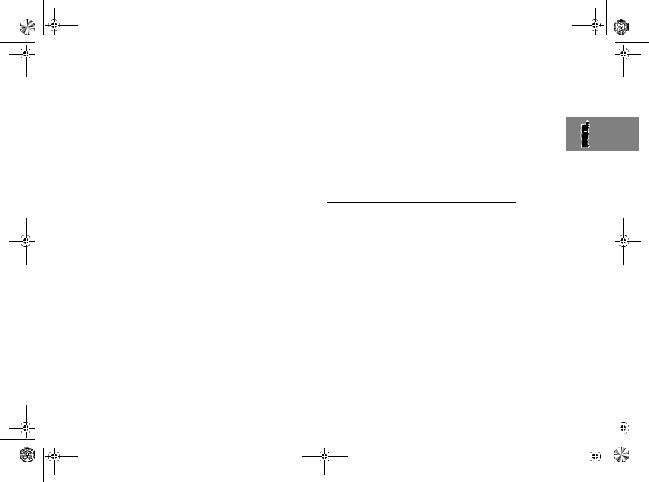
PDivert On/Off. Unconditional voice call diversion will be switched either on or off depending on the current setting.
²Real Time Clock. In the idle display, the real time clock can display the time in either a 12-hour or 24-hour format.
qBattery Charge Indicator. The more segments displayed, the greater the battery charge.
k |
In Use. Displayed when a call is in progress. |
nHome Zone. Availability depends on your service provider.
lRoam. Displayed when you are registered on a system other than your home system.
ÑAlarm On/Off. Displayed when the date book reminder setting time is reached. It switches off at the event start time.
oShort Message Service. Displayed when the phone has received a message. The symbol will flash when your message storage area is full.
pVoicemail Waiting Indicator. Displayed when you have a voice message waiting. The availability of this feature depends on your service provider.
±Answering Machine Indicator1. Displayed when there is an unread voice message.
B...K Icons are displayed when you are in the Quick Access menu.
1.This feature is not available in all countries.
In addition, when you are expected to press the Okey, a prompt will appear in the display, for example Completed.
Low Temperature Use
The liquid crystal display used in your phone will behave differently at extremely low temperatures. You may notice that the display responds slowly to key presses; this is to be expected and does not affect the phone operation in any way.
Animated Icons
A set of animated icons is provided in your phone. These icons represent current activity on your phone.
Animated Icon |
Description |
ºRinging
»Calling a number
¼Ending the call
½SMS Message sent
|
|
|
|
|
|
|
|
|
|
About Your Phone, Battery and SIM Card 17 |
English |
|
|
|
|
|
|||
|
|
|
|
|
|
|
|
|
|
|
|
|
|
|
|
|
|
|
|
|
|
|
|
|
|
|
|
|
|
|
|
|
|
|
|
|
|
|
|
|
|
|
|
|
|
|
|
|
|
|
|
|
|
|
|
|
|
|
|
|
|
|
|
|
|
|
|
|
|
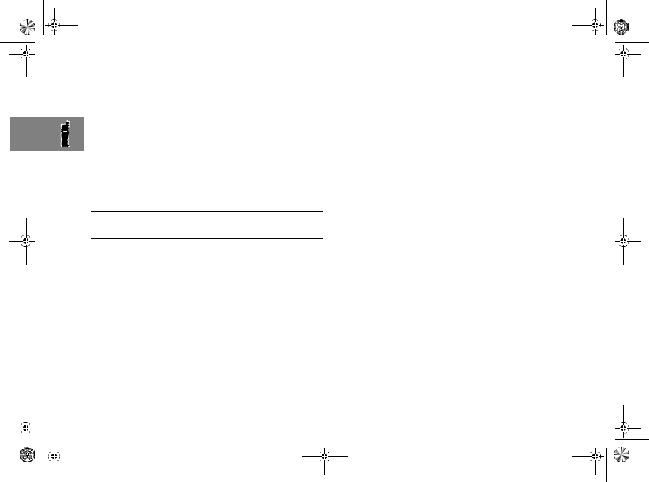
Earpiece Connector
The earpiece connector is on the left-hand side of your phone, above the volume button. Use this connector for the headset accessories available from your Motorola stockist.
Communicating with External Devices
To communicate with an external device, such as a personal computer, your phone includes the following features:
•an infra-red lens located next to the antenna on the top of the phone.
•an RS-232 serial data port located at the bottom of the phone.
Setting up the Infra-Red Feature
iPress E. Select the Quick Access feature or, after the tone, say the Voice Tag name.
Before you can transfer your data:
•Align the infra-red lens on your phone with the infra-red lens on the external device.
•Make sure that the infra-red feature is active in both the phone and the external device.
The phone and the external device can be up to 30 cm apart.
For operating details, see ‘Activate IR Port’ in the Phone Setup
Menu section of this manual.
|
|
|
|
|
|
|
|
|
|
|
|
|
|
|
English |
18 About Your Phone, Battery and SIM Card |
|
|
|
|
|
|
|
|
|
|
|
|
|
|
|
|
|
|
|
|
|
|
|
|
|
|
|
|
|
|
|
|
|
|
|
|
|
|
|
|
|
|
|
|
|
|
|
|
|
|
|
|
|
|
|
|
|
|
|
|
|
|
|
|
Setting up the RS-232 Serial Data Port
The RS-232 serial data port requires a Motorola 3-pin RS-232 serial data cable. This is available from your Motorola stockist.
To connect the cable to your external device, please refer to the manufacturer’s documentation.
Looking After Your Phone
•Never leave your phone or battery in extreme temperatures (over 60°C), for example behind glass in very hot, direct sunlight.
•To clean your phone, use a moistened or antistatic cloth. Do not use a dry or electrostatically charged cloth.
The Status Indicator
The status indicator on the top of the phone provides you with the following information:
Incoming Call |
Alternate Red/Green |
In Service |
Flashing Green |
No Service |
Flashing Red |
Roaming |
Flashing Yellow |
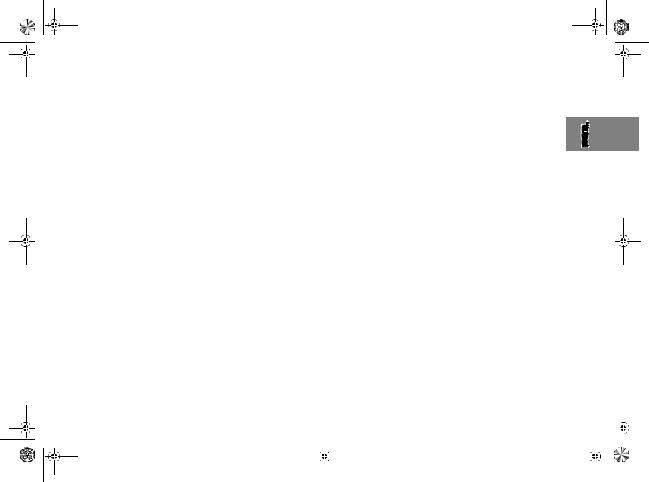
!
Your Battery
Charging a New Battery
New batteries are supplied in a totally uncharged state.
To ensure maximum battery performance, a new battery (or battery that has not been used for several months) should be charged for at least 14 hours before use.
AA new battery will require several full charge/discharge cycles in order to achieve its optimum performance.
AA new battery, or a battery that has not been used for several months, may cause a premature fully charged indication. Ignore this indication and let the battery charge for several more hours, remove and re-insert the battery into the charger, and charge for an additional 14 hours.
Important Battery Information
!Always treat your batteries with care. See ‘Warranty Information’, at the beginning of this manual.
!Never leave your battery in extremely high temperatures (over 60°C), for example behind glass in very hot, direct sunlight.
!Only Motorola Original Accessory batteries should be charged in the phone or the optional desktop charger. This is to protect you and your phone from the risks of incorrect charging.
ADo not use lithium ion batteries at extremely low temperatures as the maximum standby/talk time will not be available when cold.
To ensure that you enjoy maximum battery life and use your battery to its fullest capacity:
•The battery should be at or near room temperature when charging.
Battery Performance and Maintenance
•Best battery performance will be achieved when you regularly charge and discharge batteries as instructed in this manual.
•Battery performance is greatly affected by network coverage.
•Set Battery Saving Mode to On (see Phone Setup Menu) and/or Frequency Of Search to Slow or Medium (see Network Selection Menu.)
•If left unused, a fully charged battery will discharge itself in approximately one month.
•When not in use, store your battery uncharged in a cool, dark and dry place.
Low Battery Warning
When the battery level is low and only a few minutes of talk time remain, a warning signal (two double beeps) will sound, the border of the battery symbol will begin to flash, and Low Battery will be displayed.
When the battery is completely discharged, your phone will turn off.
|
|
|
|
|
|
|
|
|
|
|
|
|
About Your Phone, Battery and SIM Card 19 |
English |
|
|
|
|
|
||||
|
|
|
|
|
|
|
|
|
|
|
|
|
|
|
|
|
|
|
|
|
|
|
|
|
|
|
|
|
|
|
|
|
|
|
|
|
|
|
|
|
|
|
|
|
|
|
|
|
|
|
|
|
|
|
|
|
|
|
|
|
|
|
|
|
|
|
|
|
|
|
|
|
|
|
|
|
|
|
|
|
|
|
|
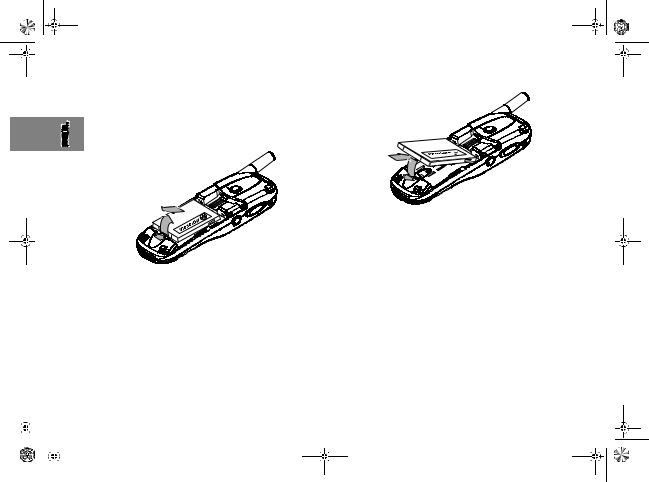
Removing Your Battery
!Switch off your phone before removing the battery. Failure to do so may damage your phone memory.
1 Press the release catch on the battery compartment and lift off the cover.
2 Push the battery towards the top of the phone and lift the battery out from the bottom end.
3Press the battery towards the connections and push it downwards until it clicks into place. Replace the cover.
Fitting Your Battery
1Remove the battery compartment cover.
2Align the connections on the battery with the connections on the phone.
|
|
|
|
|
|
|
|
|
|
|
|
|
|
|
English |
20 About Your Phone, Battery and SIM Card |
|
|
|
|
|
|
|
|
|
|
|
|
|
|
|
|
|
|
|
|
|
|
|
|
|
|
|
|
|
|
|
|
|
|
|
|
|
|
|
|
|
|
|
|
|
|
|
|
|
|
|
|
|
|
|
|
|
|
|
|
|
|
|
|
Charging Your Battery Using the Travel
Charger
The travel charger can power the phone and charge a fitted
battery.
!Ensure that the local mains voltage at your location matches that of your travel charger.
Fit a battery onto your phone.
To charge your battery:
1 Attach the correct adapter plug to the travel charger.
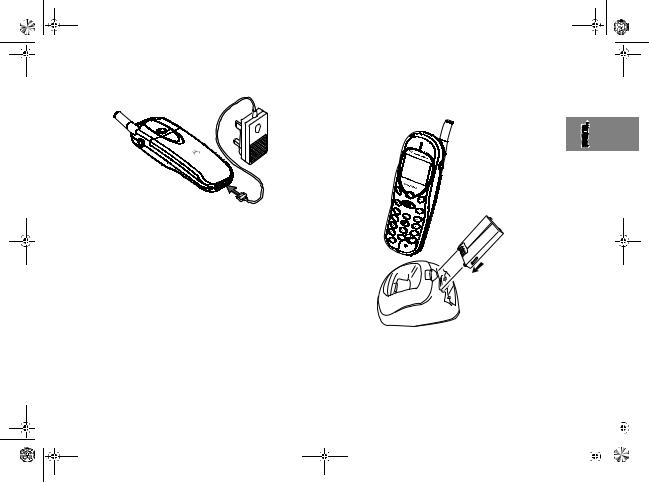
2 Connect the travel charger to the phone.
AThe connector is keyed and can only be inserted one way.
3Insert the travel charger plug into a suitable mains power socket.
A beep-tone is heard and the battery icon flashes when charging begins.
The state of charging is monitored and displayed by your phone. See ‘Battery Meter Indicators’, later in this section for details.
AYour phone can be either on or off during charging.
!Do not press Sduring charging.
Desktop Charging Your Battery
AThe Desktop Charger is an optional accessory that allows you to charge both the battery fitted in your phone and a spare battery together (phone battery followed by spare battery).
Batteries charge in about 2 to 3 hours, depending on the battery.
AIt is normal for batteries to become warm during charging.
1Connect the travel charger to the desktop charger socket. (The connector is keyed and can only be inserted one way.)
2Plug the travel charger into a standard mains socket.
3Insert your phone into the desktop charger as shown.
A spare battery can be charged on its own or at the same time as your phone. Insert the battery into the desktop charger as shown.
ACharge times will increase if you make or receive phone calls while charging.
|
|
|
|
|
|
|
|
|
|
About Your Phone, Battery and SIM Card 21 |
English |
|
|
|
|
|
|||
|
|
|
|
|
|
|
|
|
|
|
|
|
|
|
|
|
|
|
|
|
|
|
|
|
|
|
|
|
|
|
|
|
|
|
|
|
|
|
|
|
|
|
|
|
|
|
|
|
|
|
|
|
|
|
|
|
|
|
|
|
|
|
|
|
|
|
|
|
|

Connecting Data Cable
Please refer to the desktop charger instruction literature.
Battery Indicators on the Phone Display
Your Motorola cellular phone includes the Motorola Expert Performance (¢) charging system. This enables the charging circuits in both the phone and the optional (¢) desktop charger to communicate directly with the battery. Based on this communication, the charger can implement the optimum charging cycle for best performance and determine the level of charge.
Your phone monitors and displays information about your battery. The following message will appear on the phone display, as the condition occurs:
Low Battery |
The battery charge is low. The battery should |
|
|
|
be recharged. |
Insert |
Battery |
No battery fitted; external power connected |
Invalid |
Battery |
This message is accompanied by a single beep. |
|
|
Your phone is alerting you that you do not |
have charging capabilities with this battery even though the battery may be able to power the phone.
The most likely reason why your charging system does not recognise the battery is that the battery you have purchased is not a Motorola original battery and therefore does not have the communications technology built into it. All Motorola original batteries include this communications technology.
It is recommended that you use only Motorola original batteries, chargers and other accessories.
Battery Indicators on the Desktop Charger
The following LED indicators flash/light on the desktop charger base, as the condition occurs:
³Front pocket phone indicator:
Lights up yellow only when the phone is properly seated in the charger. Check the charging status on the phone display. If there is a battery in the back pocket and the phone display is off, the phone battery is fully charged.
µ´ Back pocket battery indicator:
Left side solid red indicates that the battery is charging; right side flashing yellow indicates that the battery is waiting to be charged; both sides solid green indicates that the charging is complete (battery > 90% charged); both sides flashing red indicates an invalid or faulty battery has been detected or that there are two batteries in the back pocket and the batteries will not be charged.
¶Data indicator:
Flashes green only when data is transferring to an attached PC with the appropriate optional data cable. Data transfer must be initiated through the PC.
|
|
|
|
|
|
|
|
|
|
|
|
|
|
|
|
|
English |
22 About Your Phone, Battery and SIM Card |
|||
|
|
|
|
|
|
|
|
|
|
|
|
|
|
|
|
|
|
|
|
|
|
|
|
|
|
|
|
|
|
|
|
|
|
|
|
|
|
|
|
|
|
|
|
|
|
|
|
|
|
|
|
|
|
|
|
|
|
|
|
|
|
|
|
|
|
|
|
|
|
|
|
|
|
|
|
|
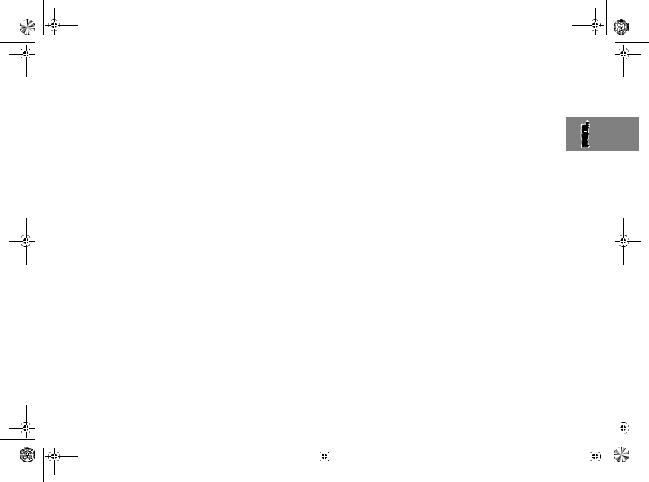
Battery Meter Indicators
The battery meter displays different messages depending on the batteries attached, and whether or not there is an external power source. The battery meter is found in the Call Related Features part of the Options Menu.
Charging Battery The battery is being charged.
Charging Complete |
Charging is complete. |
Invalid Battery Battery may be defective, or may not be a Motorola original battery.
AWhen the battery is completely discharged, you must charge the battery for one minute before you can make or accept a phone call.
Your SIM Card
Your SIM (Subscriber Identity Module) card was supplied by your Cellular Service Provider when you bought your phone. You will not be able to make or receive calls if you do not have a SIM card inserted in your phone.
ASome networks allow you to make emergency calls without a SIM card inserted.
The SIM card is a ‘Smart Card’ that contains your phone number, service details and memory for storing Phone Book numbers and messages. You can therefore use your SIM card in someone else’s GSM phone and you will be charged for the call.
Like a bank or credit card, you should keep your SIM card secure. Do not bend or scratch your card and avoid exposure to static electricity or water.
!Switch off your phone before inserting or removing the SIM card. Failure to do so may damage the memory on your SIM card.
|
|
|
|
|
|
|
|
|
|
|
|
|
About Your Phone, Battery and SIM Card 23 |
English |
|
|
|
|
|
||||
|
|
|
|
|
|
|
|
|
|
|
|
|
|
|
|
|
|
|
|
|
|
|
|
|
|
|
|
|
|
|
|
|
|
|
|
|
|
|
|
|
|
|
|
|
|
|
|
|
|
|
|
|
|
|
|
|
|
|
|
|
|
|
|
|
|
|
|
|
|
|
|
|
|
|
|
|
|
|
|
|
|
|
|
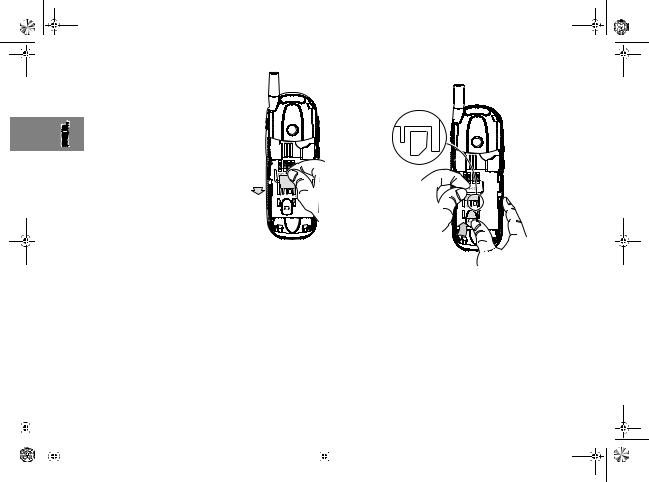
SIM Card Insertion/Removal
1 Switch off your phone by pressing and holding the Skey, remove the battery cover and the battery.
2 Press slightly at the edge of the lever marked “PRESS”.
3 Slide the SIM card into the slot in direction as indicated on the SIM card holder.
4 The SIM card stays in the holder such that the notch is in the bottom righthand corner
5 Replace the battery and battery cover.
6 To remove, press the lever inward and gently push the card up.
If the SIM card is inserted the wrong way round, or damaged, the Check Card message may be displayed. Remove the SIM card, check that it is the right way round and then re-insert it into the phone.
!To avoid damage and malfunctioning, do not deliberately pull or pry open the strips on the SIM card holder.
If either of the Bad Card See Supplier or Blocked See Supplier messages are displayed, then you will need to contact your Cellular Service Provider.
|
|
|
|
|
|
|
|
|
|
|
|
|
|
|
|
|
English |
24 About Your Phone, Battery and SIM Card |
|||
|
|
|
|
|
|
|
|
|
|
|
|
|
|
|
|
|
|
|
|
|
|
|
|
|
|
|
|
|
|
|
|
|
|
|
|
|
|
|
|
|
|
|
|
|
|
|
|
|
|
|
|
|
|
|
|
|
|
|
|
|
|
|
|
|
|
|
|
|
|
|
|
|
|
|
|
|
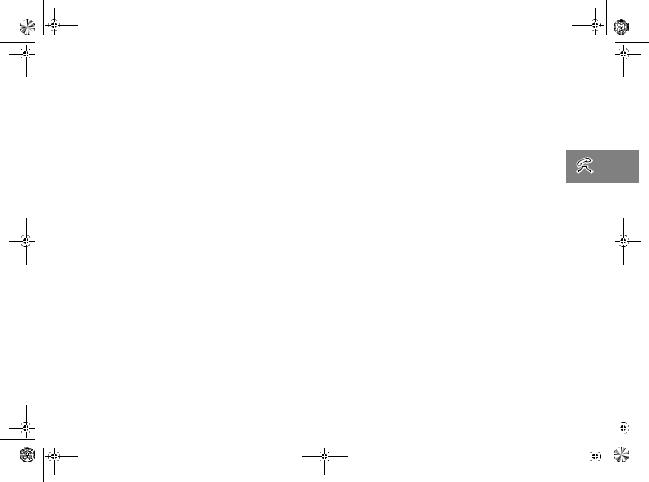
Making and Receiving Phone Calls
Switching the Phone On and Off
To switch the phone on or off, press and hold the Skey. If VibraCall™ is selected, the phone will vibrate when it is switched on.
If you switch the phone on and there is no SIM card inserted, you will be asked to insert one. Once inserted, the phone will check that the SIM card is valid.
A number of messages will then be displayed:
•Enter PIN - a request to enter the SIM card PIN code (if required).
•Enter Phone Unlock Code - a request to enter the phone unlock code (if required).
•Searching... followed by a network name - as the phone searches and then finds a suitable network to connect to.
Once switched on and connected, the phone stays in idle mode.
Entering Your SIM Card PIN Code
To enter the PIN code, enter AO.
As you type in each digit of the PIN code a * character will be displayed.
If you make a mistake, press and release the Ckey to remove the last digit. Holding the Ckey down will remove the entire entry.
When the PIN code is complete press the Okey.
If the PIN code entered is incorrect, the warning message Wrong PIN will be displayed, followed by Enter PIN.
!If the PIN number is entered incorrectly three times in a row, your phone will automatically lock-up and the Blocked message will be displayed. See ‘Unblocking Your
Phone’ for details on unblocking your phone.
The PIN code can be changed, see ‘Change SIM PIN Code’ in the Phone Setup Menu section for more details.
jEntering Your Unlock Code
If your phone displays the message Enter Phone Unlock Code you must enter your unlocking code by entering BO.
The unlock code is a four digit number which is set at manufacture to 1234. The code can be changed, see ‘Change Unlock Code’ in the Phone Setup Menu section for more details.
If you forget your unlock code, press the $ key. This will display the ‘Change Unlock Code’ option. Enter O D, enter a new unlock code, and press O.
Locking the Keypad
Press the <and >keys simultaneously to prevent accidental usage of the phone. To remove the lock, press < and >simultaneously. All keys with the exception of the S key will be disabled. You can still answer an incoming call by pressing Owhen the keypad is locked.
Making and Receiving Phone Calls 25 |
|
|
|
|
|
|
|
|
English |
|
|
|
|
||||
|
|
|
|
|
|
|
|
|
|
|
|
|
|
|
|
|
|
|
|
|
|
|
|
|
|
|
|
|
|
|
|
|
|
|
|
|
|
|
|
|
|
|
|
|
|
|
|
|
|
|
|
|
|
|
|
|
|
|
|
|
|
|
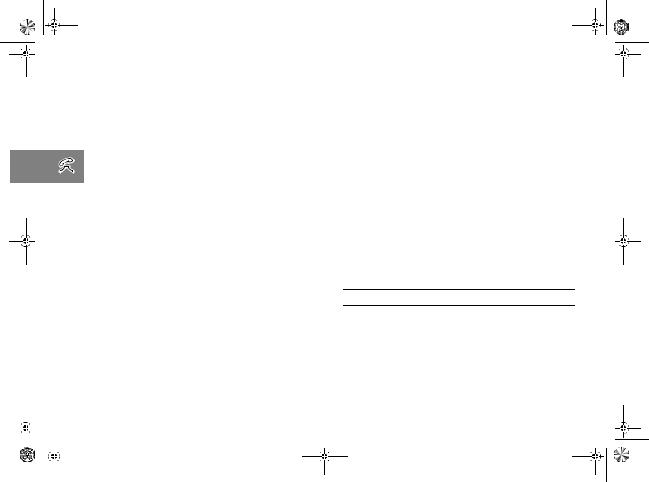
Making a Phone Call
To make a phone call, your phone must be switched on and unlocked.
It will not be possible to make a phone call unless you are in an area where there is a GSM900, 1800 or 1900 service. When a service has been found, a series of rising bars, x, will show the signal strength.
There are a number of different ways to make a phone call:
•Using the digit keys.
•Using automatic redial.
•Redialling the last number called.
•One-touch dialling a Phone Book entry*.
•Dialling a Phone Book entry*.
•Calling an embedded number in a message.
•Using the Smart button (=) and Voice Dialling.
A*Your phone contains a 'phone book' that can be used to store names and telephone numbers. See ‘What is the Phone Book?’ for further details.
The simplest method of making a phone call is to enter the number using the digit keys then press O.
AIf you make a mistake, press and release the Ckey to remove the last digit. Holding the Ckey down will remove the entire number.
To indicate that you are making a phone call, your phone displays the outgoing call animation and the word Calling. If the call is not answered and you want to end the call, press Oor close the flip (models with flip only).
When the phone call is answered, the display will change to End Call?.
To end your call, press Oor close the flip, if applicable.
Automatic Redial
If your call attempt does not succeed, the message Redial? will be displayed for five seconds. Pressing Oat this point will automatically redial the phone number.
When the call is answered, you will hear a short ring tone.
The maximum number of redial attempts is set by your Cellular Service Provider. If the phone call cannot be connected within this maximum, the message Redial Failed will be shown.
Redialling the Last Number Called
i When in standby mode, press OO.
Alternatively, you can retrieve the last number dialled using the ‘Last Ten Calls’ feature in the Phone Book menu.
|
|
|
|
|
|
|
|
|
|
|
|
|
|
|
|
|
English |
26 Making and Receiving Phone Calls |
|
|
|
|
|
|
|
|
|
|
|
|
|
|
|
|
|
|
|
|
|
|
|
|
|
|
|
|
|
|
|
|
|
|
|
|
|
|
|
|
|
|
|
|
|
|
|
|
|
|
|
|
|
|
|
|
|
|
|
|
|
|
|
|
|
|
|
|
|
|
|
